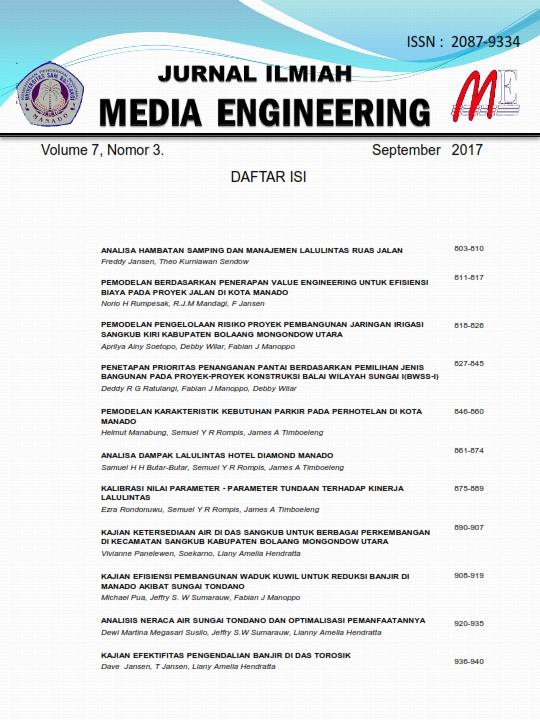Pemodelan Pengelolaan Risiko Proyek Pembangunan Jaringan Irigasi Sangkub Kiri Kabupaten Bolaang Mongondow Utara
Abstract
Irrigation is an effort to supply, regulate and dispose of irrigation water to support agriculture, swamp irrigation, underground air irrigation, pump irrigation and pond irrigation. The implementation of irrigation development in Sangkub and Bintauna sub-districts, North Bolaang Mangondow Regency, North Sulawesi Province with irrigated rice field area consisting of Sangkub Kanan and Sangkub Kiri. The construction of Left Sangkub Irrigation Network were indicated to be delayed, so there is a need to identify, analyze, mitigate and allocate all of possible risks that will occur. Regarding to this, the risk modeling were used as the basis for decision making by related parties to overcome the negative consequences that would occur in the construction of irrigation networks.
               The aims of this research are to identify various types of risks in the implementation of the construction of the Left Sangkub Irrigation Network., to know the risks that belong to the dominant category (major risk) on the implementation of the construction of Sangkub Left Irrigation Network and to design the existing system and risk mitigation management models to minimize negative things that may occur.
               In this research it were use the qualitative risk analysis method involving 10 respondents from owner, contractor and consultant. Qualitative risk analysis method aims to make description, picture or painting systematically, factually and accurately about phenomenon or relationship between phenomena to be investigated.
               Results showed that there were 47 risk had be found in the construction of Sangkub Kiri Irrigation Project, consisting of political (5), environment (5), economy (3), finance (5), natural (3), project (6), human (5), technical (9), criminal (3) and safety (3). The risk analysis indicated that there were 13 risks (27.66%) unacceptable, 25 risks (53.19%) undesirable, 7 risks (14.89%) Acceptable and 2 risks (4.26%) negligible categories.
               All of unacceptable risks were dominated by human risk including labor delays due to holidays, while undesirable risks are dominated by technical risks such as non-conformity between the volume of contract work and field conditions requiring a review of the work location.
               The risk mitigation were aims to reduce the negative impact of risks including the category of major risk. Among all 13mitigation of unacceptable risk , one of them is a mitigation to discipline the workforce and to implement a rotational work system so that workers can recover their condition. While the risks included in the undesirable category are carried out 25 mitigation actions ie mitigation actions discuss and propose changes in the volume of work with added work less to adjust between the volume of contract work and field conditions.
Â
Keywords: Risk management, irrigation network, risk mitigation, dominant category
Downloads
Published
Issue
Section
License
Copyright (c) 2019 Aprilya Ainy Soetopo, Debby Willar, Fabian J. Manoppo

This work is licensed under a Creative Commons Attribution-ShareAlike 4.0 International License.
- I declare that this paper ... (title of paper) ... is original and has not been published previously nor under consideration to be published elsewhere and that any necessary permission to quote from another source has been obtained.
- With the publication, I transfer the copyright to The Jurnal Ilmiah Media Engineering (PTSU-OJS). This copyright transfer shall cover the exclusive right to reproduce and distribute the article, including reprint, photographic reproduction of similar nature and translation. It shall also include the right to adapt the article for use in conjunction with computer system and programs including reproduction or publication in machine-readable form and incorporation in retrieval systems.
Author (also on behalf of any co-authors):
Signed
____________________Â
Name :
Date :


